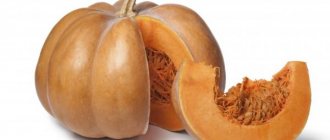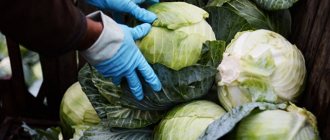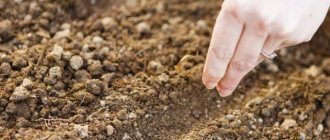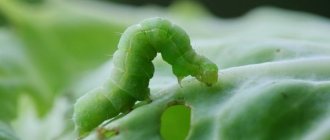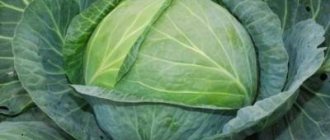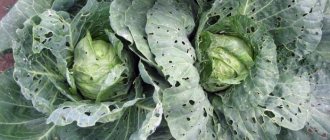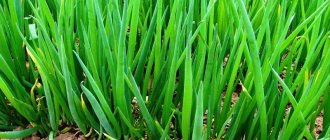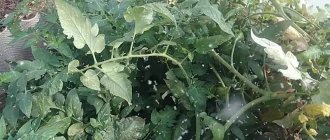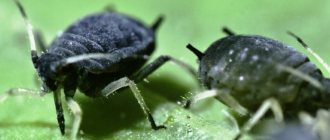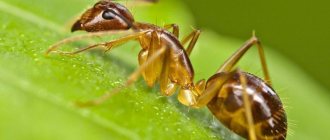It makes sense to grow Chinese cabbage. It is stored for a long time after cutting, contains a lot of useful substances, is tasty, and cooks quickly. If you have a greenhouse at your dacha or country house, then it’s not difficult to provide your family with delicious cabbages.
During the season, which in closed ground lasts from early spring to late autumn, you can harvest 2-3 crops.
Features of culture
The first thing to consider before choosing a planting time is that Chinese cabbage grows well only in short daylight conditions. Due to this feature, it is better to plant the crop in early April or August. To prevent plants from bolting, reflective screens are installed near the plantings on long summer days. Growing Chinese cabbage in a greenhouse will be successful if the daylight hours are shorter than 12 hours.
Despite the fact that seeds germinate at a temperature of +4–+5 °C, the best temperature for the formation of dense heads of cabbage is +16–+22 °C.
Important! Sudden temperature changes should not be allowed in the greenhouse, because Chinese cabbage reacts to them by shooting out arrows.
To sow crops in a greenhouse, select varieties intended for cultivation in a certain season. So in the spring, hybrid plants are planted in the greenhouse on the packaging or in the name of which it is indicated that they are intended for this period. If the time of year does not coincide with the growing period of the selected variety, the cabbage will begin to bolt. To prevent such a course of events, it is better to choose universal varieties for planting, such as the “Chinese Select” and “Mis China” hybrids.
Reviews
Mikhail, Stary Oskol
I trick my Beijing dog so that she doesn’t shoot. I sow the seeds in peat tablets at the beginning of April (from 5 to 10). When the shoots appear, I close them with cardboard boxes after 18-00. After transplanting into the greenhouse, I repeat the closing procedure, covering the ridges with black spunbond.
Nadezhda, Leningrad region
The summer was hot, we had to save the cabbage from flea beetles. I sprayed it with a vigorous solution of black and red pepper. For adhesion I added liquid soap. I won’t say that the effect was 100%, but most of the fleas stuck.
Natalya, Moscow region
Last season I planted a Monaco hybrid. He showed himself excellent. There was no bolting, the heads of cabbage were elastic, large, weighing up to 2 kg. Planted in spring and second half of summer. Both harvests were excellent. The hybrid has 100% germination rate.
Popular varieties
Before you figure out how to grow Chinese cabbage in a greenhouse, you need to choose the right variety. Thanks to the painstaking work of breeders, many varieties of vegetable crops with improved yield and cold resistance have emerged.
The most popular varieties of Chinese cabbage for growing in a greenhouse:
- Monument. With proper care, the Beijing vegetable weighs more than 3 kg;
- Wineglass. Thanks to the delicate structure of the leaves, the heads of cabbage are ideal for fresh consumption. Average weight – 2 kg;
- Stonefly. An early ripening variety of Chinese cabbage, the ripening period of which is less than 40 days. Heads of cabbage weigh 300 g;
- Autumn jade f1. A variety for autumn growing. Head length 50–60 cm, weight – 3 kg;
- September f1. An early ripening variety that is immune to plant diseases and resistant to sudden temperature changes. The weight of vegetable heads is 1.5 kg;
- Marfa. Universal early ripening variety. Less than 40 days pass from emergence to harvest. Cabbage is resistant to bolting and tolerates a lack of sunlight well. Heads of cabbage weigh about 1 kg.
All that remains is to choose the appropriate option.
Growing Chinese cabbage "Glass" from seeds in the ground
The Chinese cabbage variety “Bokal” was bred by Moscow breeders. It has unique taste properties and is a source of essential amino acids, vitamins and minerals. This is a cabbage species and belongs to the mid-season varieties.
For growing the “Glass” variety in open ground, regions where the temperature ranges from +12 to +25*C are recommended.
A significant decrease or increase in temperature and long daylight hours provoke the release of arrows and flowering. Therefore, this variety is most suitable for the summer-autumn growing period.
Sowing seeds of the "Pekinga" variety "Glass" in open ground is recommended at the end of July and at the beginning of August. Heads of cabbage will have time to form in a favorable period. “Adult” heads of cabbage are not afraid of cold weather. They easily tolerate temperature drops even down to -2*C.
Conditions in the greenhouse
For growing Chinese cabbage, structures made of film or polycarbonate with windows for ventilation are suitable. When choosing a location for installing a greenhouse, it is recommended to take into account the rules of crop rotation. So the best predecessors for Chinese cabbage are tomatoes, onions, cucumbers, zucchini, and carrots. The crop also grows well after beans, soybeans and peas.
To grow “Chinese” cabbage in winter, install a heating system that can maintain a stable temperature in the range of +13–+20 °C. In addition to warmth, Chinese cabbage needs 10 hours of daylight in the autumn-winter period. To fulfill this requirement, phytolamps are installed in the greenhouse. Along with the vitamin-rich Peking cabbage variety, garden crops with similar requirements are also grown: radishes, onions, greens.
When using a method of growing without seedlings, until the crop sprouts appear, the temperature in the greenhouse is kept at +20 °C, and then lowered to 10 °C for a week. The rest of the time the temperature is kept in the range of +15–+20 °C.
Advantages and disadvantages
Among the advantageous features of cultivating Chinese cabbage in greenhouse conditions are:
- The ability to maintain constant conditions necessary for high-quality cultivation: temperature, humidity, average consistency of loose soil.
- Growing vegetables throughout the year with heating in greenhouses.
- Independent regulation of daylight hours.
- Obtaining several harvests (three times harvest) in 1 season.
Gardeners include the following criteria as disadvantages:
- The complexity of the process.
- Increased costs for arrangement and maintenance of greenhouses.
- The need to control the conditions for growing vegetables.
- Mandatory ventilation of premises.
Preparation of planting material
Hand-picked Chinese cabbage seeds or those that have not been processed by the manufacturer are soaked in a 1% solution of potassium permanganate for half an hour. Biological products “Fitosporin-M” and “Baktofit” are also used as a disinfectant liquid for pre-sowing treatment of crop planting material. The solution is prepared in accordance with the instructions supplied with the selected product.
Immediately before planting in pots or in a greenhouse, Chinese cabbage planting material is soaked for 12 hours in a growth stimulator. Popular products are “Epin”, “Zircon”.
Where is it better to plant Chinese cabbage in the sun or in the shade?
Chinese cabbage is a light-loving plant. Therefore, the bed for planting it must be chosen in a well-lit area. Under no circumstances should petsai be planted in the shade.
However, we must not forget that “Pekinga” is a plant of short daylight hours (up to 12 hours). If this parameter is not observed, then the heads of cabbage will not form, the cabbage will sprout and bloom.
Therefore, petsai are grown either in early spring or in the summer-autumn period, when daylight hours are not maximum.
If you do not meet these deadlines, then in order to shorten the daylight hours, the cabbage is shaded with material that does not transmit light (black agrofibre).
How to grow seedlings
Since Chinese cabbage does not like transplants due to its sensitive root system, it is better to sow the seeds of this crop in purchased peat pots or tablets. As a last resort, ordinary pots filled with a light peat substrate to which mineral fertilizer has been added are used as containers for planting plants. To avoid infection of young plants, the soil is treated with a pink solution of potassium permanganate.
Chinese cabbage seedlings are grown as follows:
- 3 seeds are planted in each container to a depth of 1 cm. At a comfortable temperature, seedlings appear within 3 days.
- Among the sprouts, the strongest is left.
- As soon as the seedlings form cotyledon leaves, the container with the seedlings is placed in a lighted place, and the glass is removed.
- The temperature in the room where the container with young plants is located is dropped from +22–23+ to +18 °C.
Water the cabbage as the substrate dries. Since fragile plants are very sensitive to lack of moisture, severe drought should not be allowed. Ideally, the substrate should always be moderately moist.
Chinese cabbage with 3 pairs of leaves, which appear 25–28 days after germination, is planted in a permanent place. In the greenhouse, plants are placed according to a 20x30 cm pattern.
When and how to plant Chinese cabbage seedlings in open ground
Growing Chinese cabbage without seedlings in the spring is suitable for the southern regions, and in the summer-autumn period - for any region. For colder and northern regions, the seedling method is used.
The timing of planting Chinese cabbage seedlings is determined at the stage of sowing seedlings. First of all, the climate zone and long-term weather observations are taken into account. If the weather in your region allows you to plant Petsai in open ground in the spring, for example, on April 20, then sowing seeds for seedlings should be done 20-25 days from this date (March 25-April 1).
The seedlings are transplanted into open ground after the formation of 3-5 leaves at an “age” of about 25 days. To form full-fledged heads of cabbage, this crop requires a short daylight hours (no longer than 12 hours) and a temperature range from +16 to 20*C. If these parameters are not provided, the cabbage bolts, blooms and does not produce a harvest.
How to plant seedlings:
- To plant Peking seedlings, you need to choose a bed that is well lit by the sun before lunch, and in the afternoon there is partial shade. When digging, the soil must be fertilized with humus and deoxidized with wood ash. A few days before planting the seedlings, the bed should be covered with film so that the soil is well warmed by the sun. Then moisten well. The soil should be loose, airy and water-permeable.
- Using a marker with a row spacing of 40-50 cm, draw rows. In rows at a distance of 35-40 cm, make holes with a diameter of about 15 cm.
- Pour warm water into the holes and place peat pots with seedlings or plants with a lump of earth carefully removed from plastic glasses in the center of them. Sprinkle wood ash around the plants.
- To protect from direct sunlight, it is best to place arcs over the bed and cover the plants with agrofibre. The shelter will protect the cabbage from temperature changes, from wind, from insect pests, and will also help retain moisture.
When carrying out further agrotechnical measures (moderate watering, weeding, fertilizing, loosening), the Pekinka will delight you with beautiful heads of cabbage.
Care
Depending on the presence of a heating system in the greenhouse, Chinese cabbage seeds are planted in the ground in March or April. To disinfect the soil from accumulated pathogens and pests, before picking vegetable seedlings, the bed is spilled with a solution of potassium permanganate or copper sulfate. Planting material is scattered into grooves 1.5 cm deep, covered with soil, and watered. Seed consumption per 1 m2 of area – 2 g.
Growing and caring for Chinese cabbage in a greenhouse includes:
- thinning. As soon as the seedlings become stronger, excess sprouts are removed, leaving only strong specimens. The next time the plantings are thinned out a week after the first manipulation. The interval between the remaining plants is 20–30 cm;
- watering. Since all crops with a shallow root system, Chinese cabbage is very demanding of moisture. Therefore, you need to carefully monitor the condition of the soil and water it on time;
- fertilizing Despite its short growing season, Chinese cabbage does not have time to deplete the soil and does not need to be fertilized. In order for the crop to grow well, the soil is fertilized in the fall. To do this, add 2 tbsp per 1 m2 for digging. potassium sulfate, 1 tbsp. superphosphate. Since the plant prefers to live in a neutral environment, lime is added to the acidic soil. If the soil was not fertilized before winter, it is enriched before planting. As a spring fertilizer, use a mixture of 1 tbsp. ash, 2 tbsp superphosphate, 1 tsp. urea. Drooping plants are fed with a weak organic solution or compost.
Some gardeners, in order to achieve maximum yield from Chinese cabbage, apply organic fertilizers or mineral mixtures with a high nitrogen content to the crop in excess quantities. Despite the rapid growth of plants, this cannot be done, because Chinese cabbage has the ability to accumulate nitrates.
Important! The slightest excess of nitrogen concentration leads to the fact that heads of Chinese cabbage become unfit for consumption.
Diseases
Due to improper watering regime, cabbage suffers from fungal diseases. Most often the crop suffers from blackleg, clubroot, powdery mildew and bacteriosis. They fight diseases with folk remedies or industrial fungicides.
Plants affected by black ring spot or mosaic cannot be treated. To prevent the spread of the virus, diseased specimens are pulled out, taken out of the greenhouse and destroyed.
Pest Control
When growing Chinese cabbage in a greenhouse, special attention is paid to pest control. The main enemy of the crop, as well as all other types of cabbage, is the cruciferous flea beetle. You can prevent the colonization of the greenhouse by voracious insects and damage to the presentation of the heads of cabbage by using the following actions:
- Abundant watering. Moisture will repel the flea, which likes to live in dry environments. In addition, water will stimulate plants to actively grow.
- Treatment with tobacco and ash. The row spacing is generously sprinkled with finely ground substances.
- Spraying. Cabbage is treated with an infusion of dandelion roots, tomato tops or wormwood.
- Selecting the right neighbors. Little aggressors are repelled by the smell of cumin, dill, coriander, and mint.
- Shelter. Light agrofibre, lutrasil, and spunbond are laid on top of young plants.
It is possible to treat cabbage, regardless of the variety, with aggressive pesticides only in case of a strong threat to the future harvest. The crop is sprayed with such preparations when there is more than a month left before the expected date for cutting the heads of cabbage.
The second pest of Chinese cabbage is slugs. The reason for the appearance of uninvited guests in the greenhouse is excessive watering. To get rid of aggressors, burdocks or boards are placed between the rows of plants. After some time, the pests hiding under the shelters are collected manually.
We make greenhouses for cabbage seedlings with our own hands
Year-round cultivation of Chinese cabbage will require a suitable greenhouse. In principle, the greenhouse is also suitable for growing types of cabbage such as white and cauliflower, other vegetable crops, berries and herbs.
A greenhouse for cabbage seedlings can be made from polyethylene
There are several types of greenhouses:
- The best option is structures made of glass and polycarbonate, since they have insulated walls, and polycarbonate, moreover, does not sag under the snow in winter;
- A combined structure with walls made of foam concrete and a roof made of polycarbonate is also suitable for use all year round;
- A semi-underground greenhouse is a dug pit with a roof erected over it; sufficient depth allows the ground not to freeze, but it will require lighting and high-quality waterproofing in case of flooding with groundwater.
Based on all that has been said, the most common and convenient is a polycarbonate greenhouse, which you can build with your own hands.
For construction, a strip foundation is most often chosen; it is best to make masonry from stone or concrete for the stability of the structure. Metal profiles can be used as a frame - they are more reliable than wood and heavier than aluminum.
First, vertical beams are installed, after which the rear and front walls are erected. The structure is attached by welding.
The frame can be covered with sheet polycarbonate; there is a certain technology for this. All gaps are carefully sealed. Now you need to equip the room.
Productivity
Chinese cabbage is an early ripening and high-yielding plant. By observing agrotechnological requirements, it is possible to harvest 600–1000 kg of healthy vegetables from 1 hundred square meters of greenhouse beds. This figure may be lower if you choose the wrong variety and improper care.
Unlike other types of cabbage, the Beijing variety matures in only 45–60 days. Thanks to this early ripening, it is possible to harvest 3 harvests of healthy vegetables in the greenhouse. Peking cabbage is especially popular and therefore expensive in early spring.
Cleaning and storage
Heads of Chinese cabbage are cut off immediately after the number of leaves exceeds 10 and their length reaches 10-15 cm. Spring varieties are ready for harvesting in early July, autumn varieties - in late September-early October. Cabbage, which was grown as a seal, is removed as soon as the main crop begins to actively grow.
Important! It is impossible to keep Chinese cabbage in the garden after ripening, as they begin to bloom.
Heads of vegetable crops are removed from the garden according to the following plan:
- A week before harvesting, stop watering the plants.
- Since the tender leaves wither quickly, harvesting is done early in the morning.
- The heads of cabbage are cut off at the base, leaving a few leaves on the spine. The remainder is fed to domestic animals.
- Spring cabbage is eaten, and autumn cabbage is stored.
To keep the heads of cabbage longer, before storing, they are alternately wrapped in cling film and paper. Provided that the temperature in storage is kept above zero, cabbage can be stored for 4–5 months.
